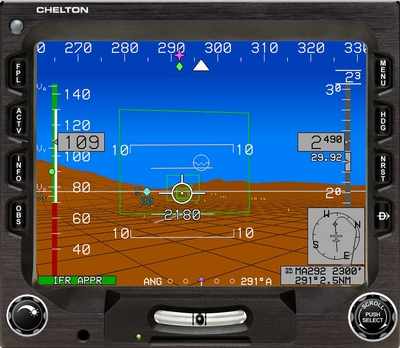Sun, Apr 13, 2008
Field Installations Begin In Alaska
ADS-B is coming... and Chelton Flight Systems says it will be
ready. The company tells ANN it recently began field installation
of version 6.0B software in southeastern Alaska under the Capstone
Phase II Program.

Chelton Product Support is working in conjunction with the
Federal Aviation Administration (FAA) and the University of Alaska
Anchorage to update software on and provide operator training for
nearly 90 Part 23 aircraft during the months of March and April.
Software version 6.0B was TSO’d in December, 2007 and is
DO-178B Level-A certified. Among its 40 new end-user benefits is
the ability to integrate with and display Automatic Dependent
Surveillance Broadcast (ADS-B) on Chelton’s Synthetic Vision
EFIS displays, greatly enhancing pilot awareness and flight
safety.
ADS-B works differently than conventional radar, which bounces
radio waves from terrestrial antennas off of airborne targets and
then interprets the reflected signals. Typically, ADS-B-capable
aircraft will use an ordinary GPS navigation receiver to determine
its position, and then combine that position with several aircraft
parameters, such as flight number, heading, speed, and altitude.
This data is simultaneously broadcast to other ADS-B-equipped
aircraft and to ASD-B ground stations, or to satellite
communications transceivers which relay the aircraft information to
Air Traffic Control centers.
Installation of 6.0B and pilot training is part of Chelton
Flight Systems’ contract under the Capstone Program, a joint
industry and FAA Alaskan Region initiative to improve aviation
safety in that state. As part of that program, Chelton fielded
Synthetic Vision systems with Terrain Awareness and Warning Systems
(TAWS), eliminating the incidence of CFIT accidents among equipped
Part 23 aircraft. The addition of an ADS-B datalink capability to
Synthetic Vision-equipped aircraft will result in even greater
situational awareness, improved safety in poor visual conditions,
and a reduced the risk of runway incursions in addition to
providing weather products (including METAR and TAF
information).
Chelton Flight Systems, part of the Cobham Avionics &
Surveillance Division, is the manufacturer of the world’s
first FAA-certified synthetic vision EFIS, which is now STC’d
on over 740 airplane and helicopter models.
More News
Light Gun A handheld directional light signaling device which emits a brilliant narrow beam of white, green, or red light as selected by the tower controller. The color and type of>[...]
"The journey to this achievement started nearly a decade ago when a freshly commissioned Gentry, driven by a fascination with new technologies and a desire to contribute significan>[...]
Aero Linx: JAARS, Inc. For decades now, we’ve landed planes on narrow rivers and towering mountains. We’ve outfitted boats and vehicles to reach villages that rarely se>[...]
"Our driven and innovative team of military and civilian Airmen delivers combat power daily, ensuring our nation is ready today and tomorrow." Source: General Duke Richardson, AFMC>[...]
Aircraft Conflict Predicted conflict, within EDST of two aircraft, or between aircraft and airspace. A Red alert is used for conflicts when the predicted minimum separation is 5 na>[...]
 ANN's Daily Aero-Term (04.20.24): Light Gun
ANN's Daily Aero-Term (04.20.24): Light Gun Aero-News: Quote of the Day (04.20.24)
Aero-News: Quote of the Day (04.20.24) ANN's Daily Aero-Linx (04.21.24)
ANN's Daily Aero-Linx (04.21.24) Aero-News: Quote of the Day (04.21.24)
Aero-News: Quote of the Day (04.21.24) ANN's Daily Aero-Term (04.21.24): Aircraft Conflict
ANN's Daily Aero-Term (04.21.24): Aircraft Conflict



